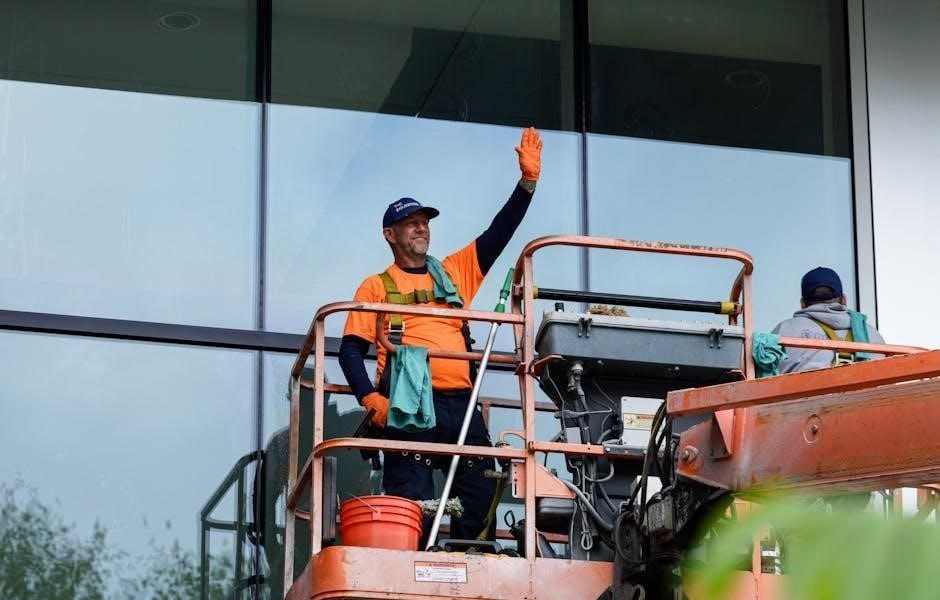
lift manual
Manual lifts are essential tools designed to simplify lifting tasks, enhancing safety and efficiency across various industries․ They require minimal effort to achieve significant lift, making them indispensable for material handling, healthcare, and logistics․
1․1 Definition and Purpose of Manual Lifts
Manual lifts are mechanical devices designed to assist in lifting and moving loads with minimal effort․ They are widely used in industries like healthcare, shipping, and manufacturing to enhance efficiency and safety․ These tools reduce physical strain by enabling users to lift heavy objects effortlessly, making them indispensable for tasks requiring precision and control․ The primary purpose of manual lifts is to simplify lifting processes while minimizing the risk of injury and improving operational productivity․
1․2 Historical Development of Manual Lifting Technology
Manual lifting technology has evolved significantly over the years, from basic mechanical systems to advanced hydraulic solutions․ Early manual lifts relied on simple levers and pulleys, while modern designs incorporate smart technology and ergonomic principles․ This progression has enhanced safety, efficiency, and adaptability, ensuring manual lifts meet diverse industrial needs․ The integration of innovative materials and mechanisms has further improved performance, making manual lifts indispensable in various sectors today․
1․3 Importance of Manual Lifts in Various Industries
Manual lifts play a crucial role in enhancing efficiency and safety across industries․ In healthcare, they enable safe patient mobility, reducing caregiver strain․ In shipping, they facilitate container handling, while in manufacturing, they simplify material movement․ These tools are vital for minimizing workplace injuries, optimizing workflows, and ensuring precise load management, making them indispensable in modern industrial and caregiving environments․ Their versatility and reliability contribute significantly to operational success․

Types of Manual Lifts
Manual lifts are categorized into hydraulic, mechanical, chain hoist, and lever-operated models․ Each type offers unique benefits, from smooth operation to portability, catering to diverse industrial needs․
2․1 Hydraulic Manual Lifts
Hydraulic manual lifts utilize fluid pressure to lift heavy loads with minimal effort․ They feature a foot pump and hand lever design, allowing hands-free operation and energy efficiency․ These lifts are ideal for applications requiring smooth, controlled movements․ Their robust construction ensures durability and reliability, making them a popular choice in industrial and warehousing settings․ Regular maintenance ensures optimal performance and longevity․
2․2 Mechanical Manual Lifts
Mechanical manual lifts operate using levers or gears to amplify lifting force, enabling easy handling of heavy loads․ They are cost-effective, durable, and require minimal maintenance․ These lifts are ideal for precise tasks and are widely used in construction, manufacturing, and logistics․ Their simple design ensures reliability, making them a practical choice for applications where hydraulic systems are not necessary․ They provide a mechanical advantage, enhancing lifting efficiency without compromising safety or performance․
2․3 Chain Hoist Manual Lifts
Chain hoist manual lifts are versatile, portable devices that use a chain and pulley system to lift loads․ They are highly durable and suitable for heavy-duty applications in construction, shipping, and manufacturing․ These lifts offer precise control and are easy to operate, making them ideal for environments where power sources are unavailable․ Their robust design ensures reliability, and they are often preferred for their simplicity and effectiveness in lifting heavy materials safely and efficiently․
2․4 Lever-Operated Manual Lifts
Lever-operated manual lifts are simple, cost-effective solutions for lifting tasks․ They use a lever mechanism to amplify lifting force, making it easier to handle heavy loads․ These lifts are ideal for applications where portability and ease of use are crucial, such as in warehouses, construction sites, or small workshops․ Their compact design and manual operation ensure reliability, while their low maintenance requirements make them a practical choice for various industrial and commercial settings․

Safety Guidelines for Manual Lifting
Proper lifting techniques and adherence to weight limits are crucial to prevent injuries․ Always maintain a natural posture, bend knees, and lift close to the body․
3․1 Proper Lifting Techniques
Proper lifting techniques are essential for safety․ Bend knees, keep back straight, and lift close to the body․ Use leg muscles to power the lift, not the back․ Keep shoulders level and avoid twisting․ Ensure a secure grip and stable stance․ Regular training reinforces these practices, preventing injuries and ensuring efficiency in tasks․
3․2 Weight Limits and Safety Standards
Weight limits and safety standards ensure safe manual lifting practices․ These limits vary by jurisdiction and equipment type, with guidelines like OSHA’s lifting equation to determine safe weights․ Regular inspections and certifications are mandatory to maintain compliance․ Adhering to these standards prevents injuries and equipment damage, promoting a safer working environment․ Proper training and understanding of these limits are critical for efficient and injury-free operations․
3․3 Personal Protective Equipment (PPE)
Personal Protective Equipment (PPE) is crucial for ensuring safety during manual lifting operations․ Gloves prevent cuts and improve grip, while safety glasses protect eyes from falling debris․ Steel-toe boots safeguard feet from heavy objects, and back supports reduce strain․ Proper PPE ensures compliance with safety regulations, minimizing workplace injuries and enhancing overall operational safety․ Always use PPE recommended by manufacturers and industry standards to maintain a secure working environment․
3․4 Emergency Procedures
In case of an emergency, release the manual lift’s load carefully using the quick-release mechanism․ Ensure the area is clear to prevent accidents․ If the load cannot be lowered, secure it firmly․ Attend to any injuries immediately and seek medical help if necessary․ Always follow the manufacturer’s emergency guidelines and ensure proper training on emergency protocols․ Regular practice of these procedures ensures swift and safe responses during critical situations․

Operating Instructions for Manual Lifts
Always inspect the lift before use, ensuring proper function and load capacity․ Position the load centrally, then lift smoothly using lever or pedal controls․ Maintain control during operation․
4․1 Pre-Operation Checks
Before using a manual lift, perform essential pre-operation checks to ensure safety and functionality․ Inspect hydraulic fluid levels, lubrication, and wearable parts․ Verify that all components, such as chains and levers, are in good condition․ Check for any leaks or damage․ Ensure the load capacity is not exceeded and that the area is clear of obstructions․ Proper preparation prevents accidents and extends equipment lifespan․ Always adhere to manufacturer guidelines․
4․2 Step-by-Step Lifting Process
Begin by positioning the manual lift correctly under the load, ensuring stability․ Engage the lifting mechanism, whether hydraulic or mechanical, using the foot pedal or hand lever․ Slowly and smoothly lift the load, maintaining control throughout․ Keep the load balanced and close to the lift․ Once at the desired height, carefully move the load to its destination․ Always maintain proper posture and use PPE for added safety․ Refer to the manual for specific model instructions․
4․3 Lowering and Storing the Load
To lower the load safely, release the lifting mechanism gradually, ensuring controlled descent․ Avoid sudden drops to prevent damage or accidents․ Once the load is on the ground, disengage the lift and secure the load․ Store the manual lift in a dry, clean area, away from hazards․ Regularly inspect and maintain the lift to ensure optimal performance and longevity․ Always follow the manufacturer’s guidelines for storage and maintenance․
4․4 Troubleshooting Common Issues
Common issues with manual lifts include hydraulic fluid leaks, uneven load distribution, or mechanical malfunctions․ Always check fluid levels and ensure the load does not exceed capacity․ If the lift struggles to raise, inspect for blockages or worn components․ Lubricate moving parts regularly and tighten loose connections․ For persistent problems, consult the user manual or contact a professional technician․ Regular maintenance can prevent many issues and ensure smooth operation․

Maintenance and Repair of Manual Lifts
Regular lubrication of moving parts and checking hydraulic fluid levels are crucial for maintaining manual lifts․ Replace worn components promptly to ensure optimal performance and safety․
5․1 Regular Maintenance Schedule
A regular maintenance schedule for manual lifts ensures longevity and reliability․ Daily checks should include inspecting hydraulic lines, chains, and worn components․ Weekly, lubricate moving parts to prevent friction․ Monthly, inspect wire ropes and fluid levels, replacing them as needed․ Document all inspections and repairs, and refer to the manufacturer’s manual for specific maintenance intervals to ensure optimal performance and safety․
5․2 Lubrication and Hydraulic Fluid Check
Regular lubrication of moving parts ensures smooth operation and prevents wear․ Hydraulic fluid levels should be checked before each use and topped up as needed․ Use the recommended fluid type to maintain system performance․ Grease-lubricated components, like chains or gears, should be serviced every 500 hours or as specified․ Always refer to the manual for specific intervals and guidelines to maintain optimal functionality and safety․
5․3 Replacement of Wearable Parts
Regular inspection of wearable parts, such as chains, cables, and hydraulic seals, is crucial for maintaining manual lift performance․ Replace worn or damaged components promptly to prevent equipment failure․ Always use OEM-approved parts to ensure compatibility and safety․ Lubricate new parts before installation and follow the manufacturer’s guidelines for proper replacement procedures․ This ensures optimal functionality and extends the lifespan of the manual lift system․
5․4 DIY Repair Tips
For minor repairs, always follow the manufacturer’s instructions and safety guidelines․ Use the correct tools and ensure the lift is properly secured before starting․ Lubricate moving parts and inspect for wear; Replace damaged components promptly to prevent further issues․ If unsure, consult the user manual or seek professional assistance․ Regular DIY maintenance can extend the lifespan of your manual lift, ensuring reliable performance and safety․ Always test the lift after repairs to confirm proper operation․

Specialized Manual Lifts
Specialized manual lifts cater to specific industries, offering tailored solutions for unique tasks․ Examples include patient lifts for healthcare, container lifts for shipping, and furniture lifts for moving heavy appliances․
6․1 Patient Lifts for Healthcare
Patient lifts are essential tools in healthcare, designed to safely transfer individuals with mobility challenges․ They enhance patient comfort, reduce caregiver strain, and improve hygiene․ Models like the Invacare Reliant series offer reliable performance, while manual patient lifts provide cost-effective solutions․ These devices are crucial for maintaining patient dignity and preventing injuries during transfers․ Proper training and adherence to safety guidelines ensure effective use in clinical settings․
6․2 Container Lifts for Shipping
Container lifts are specialized tools enabling efficient handling of shipping containers․ The C-Lift M Series by Bison Group allows independent container lifting in various locations, enhancing logistics․ These lifts ensure safe, precise movements, reducing strain on handlers and minimizing risks․ They are indispensable for streamlining operations in ports and warehouses, ensuring cargo security and operational efficiency․ Proper training and adherence to safety guidelines are crucial for optimal use in shipping environments․
6․3 Furniture and Appliance Lifts
Furniture and appliance lifts are designed to handle bulky items securely․ They often feature adjustable forks and fixed legs, allowing precise placement․ These lifts are ideal for moving heavy furniture, appliances, and pallets in both residential and commercial settings․ With capacities up to 440 lbs and lift heights of 35 inches, they provide efficient solutions for material handling needs, ensuring safety and minimizing strain during relocation or installation tasks․
6․4 Industrial Stackers and Pallet Lifts
Industrial stackers and pallet lifts are robust tools designed for heavy-duty material handling in warehouses and production facilities․ They feature hydraulic systems that allow for smooth lifting and lowering of loads, often operated via foot pedals or hand levers․ With capacities up to 2,000 lbs, these lifts enhance efficiency and safety by minimizing manual strain during stacking and pallet management․ Their durable construction ensures long-term reliability in demanding environments․
Manual lifts must adhere to strict safety standards set by OSHA and EU regulations, ensuring compliance through regular inspections and certifications to prevent workplace accidents and injuries․ OSHA guidelines for manual lifting emphasize employee safety by setting weight limits and requiring proper training․ Employers must ensure workers use correct lifting techniques, maintain equipment, and adhere to safety standards․ Regular inspections and certifications are mandatory to comply with regulations․ Proper documentation of training and incident reporting is also required to prevent workplace injuries and ensure legal compliance․ These guidelines aim to minimize risks associated with manual lifting tasks․ The European Union has established strict standards for manual lifts, ensuring safety and reliability․ These standards cover design, testing, and operation, with a focus on user protection․ Compliance with EU directives is mandatory, requiring manufacturers to meet specific technical and safety criteria․ Regular inspections and certifications are necessary to maintain compliance, ensuring that manual lifts operate safely and efficiently across all member states․ These standards aim to reduce workplace accidents and enhance overall safety․ Certifications and inspections are critical for ensuring the safe operation of manual lifts․ Regular inspections must be conducted to verify compliance with safety standards and identify potential issues․ Certifications often involve third-party verification of design and operational integrity․ Documentation of inspections and maintenance is essential for legal compliance and workplace safety․ Failure to comply can result in operational shutdowns or legal penalties․ Proper certification ensures reliability and user confidence in manual lift systems․ Proper training is crucial for safe and efficient manual lift operations․ Comprehensive programs, including workshops and online resources, ensure employees master lifting techniques and safety protocols․ Employee training programs are vital for ensuring safe and effective use of manual lifts․ These programs cover proper lifting techniques, safety protocols, and equipment operation․ They often include hands-on practice and theoretical knowledge to enhance understanding․ Regular updates and refreshers are essential to maintain compliance with industry standards and prevent accidents․ Employers must prioritize these programs to foster a culture of safety and efficiency in the workplace․ Safety workshops and seminars provide in-depth training on manual lift operations, focusing on injury prevention and compliance with regulations․ These sessions often feature interactive demonstrations, case studies, and open discussions․ Experts share best practices, emphasizing proper lifting techniques and equipment maintenance․ Participants gain practical insights to reduce workplace hazards and improve overall safety standards․ Regular attendance is encouraged to stay updated on the latest industry guidelines and advancements in manual lifting technology․ Online resources and manuals provide accessible guidance for manual lift operations, offering downloadable PDFs, instructional videos, and training materials․ Websites like SMART LIFT and Moris Manuals offer detailed guides on equipment usage, maintenance, and safety protocols․ These resources ensure users stay informed about best practices, safety standards, and compliance requirements, making them invaluable for both professionals and beginners in manual lifting applications․ Regular updates keep the information current and relevant․
Manual lifts have proven their effectiveness in diverse industries through real-world applications, showcasing their versatility and efficiency in handling materials, patients, and equipment safely and effectively․ Manual lifts have revolutionized industrial operations, enhancing efficiency and safety․ Companies like Bison Group’s C-Lift M Series enable independent container handling, reducing workload and downtime․ Hydraulic and mechanical lifts in manufacturing plants have minimized workplace injuries, while chain hoists in logistics streamline material movement․ These solutions demonstrate how manual lifts optimize workflows, ensuring productivity and safety in demanding environments․ Real-world applications highlight their versatility and effectiveness in meeting industrial challenges․ Manual lifts are vital in healthcare, ensuring patient safety and caregiver well-being․ Devices like the Invacare Reliant Lift provide mobility support, reducing strain during transfers․ These lifts enhance dignity and comfort for patients while preventing injuries among staff․ Their use in hospitals and clinics exemplifies how manual lifting technology adapts to meet specific healthcare needs, fostering a safer and more compassionate care environment․ Manual lifts are crucial in warehousing for efficient material handling․ Devices like the Presto Lifts Manual Drive Stackers, with capacities up to 2,000 lbs, enable easy lifting and stacking of pallets․ Adjustable forks and fixed legs provide stability, while hydraulic systems reduce strain․ These tools enhance productivity, ensuring safe and precise movements of goods․ Their versatility makes them indispensable in busy warehouse environments, streamlining operations and minimizing manual effort․ Future trends include integration of smart technology, eco-friendly solutions, and customizable designs․ Innovations like smart lifts enhance efficiency and safety, while eco-friendly options reduce environmental impact globally․ The integration of smart technology into manual lifts enhances efficiency and safety․ IoT-enabled lifts provide real-time monitoring, optimizing performance and reducing downtime․ Automated systems simplify operations, while data analytics improve maintenance scheduling․ Smart lifts also incorporate safety features like collision detection and load monitoring, ensuring safer working conditions․ This technological advancement is transforming manual lifting into a more intelligent and user-friendly solution across industries․ Eco-friendly manual lift solutions are gaining popularity as industries prioritize sustainability․ These lifts often utilize recycled materials, energy-efficient designs, and low-carbon manufacturing processes․ Companies are innovating to reduce environmental impact while maintaining performance․ For instance, manual lifts made from lightweight, durable materials minimize resource consumption․ Additionally, some models incorporate renewable energy sources, further aligning with global sustainability goals․ These solutions support green initiatives without compromising functionality or safety standards․ Customizable lift designs allow users to tailor equipment to specific needs, enhancing productivity and versatility․ These lifts can be adapted for different load types, workspace constraints, and industry requirements․ Adjustable features such as fork lengths, lifting heights, and frame configurations ensure optimal performance․ Modular components enable easy upgrades, making these lifts cost-effective and future-proof․ This adaptability is particularly valuable in dynamic environments where flexibility is key to meeting diverse operational demands efficiently․
Legal and Regulatory Compliance
7․1 OSHA Guidelines for Manual Lifting
7․2 European Union Standards for Manual Lifts
7․3 Certifications and Inspections

Training and Education
8․1 Employee Training Programs
8․2 Safety Workshops and Seminars
8․3 Online Resources and Manuals

Case Studies and Real-World Applications
9․1 Success Stories in Industrial Settings
9․2 Manual Lifts in Healthcare Facilities
9․3 Use of Manual Lifts in Warehousing

Future Trends in Manual Lifting Technology
10․1 Integration of Smart Technology
10․2 Eco-Friendly Manual Lift Solutions
10․3 Customizable Lift Designs
Related Posts

chamberlain liftmaster professional 1/2 hp manual pdf
Get the Chamberlain LiftMaster Professional 1/2 HP manual PDF for free. Comprehensive guide for installation, troubleshooting, and maintenance.

maytag mvwc565fw2 manual
Get the Maytag MVWC565FW2 manual for free! Download user guide, troubleshooting tips, and repair help for your washer.

cfmoto service manual free download
Need a CFMoto service manual? Stop searching! Download your free guide now and get back on the road or trail. Easy access, no cost!